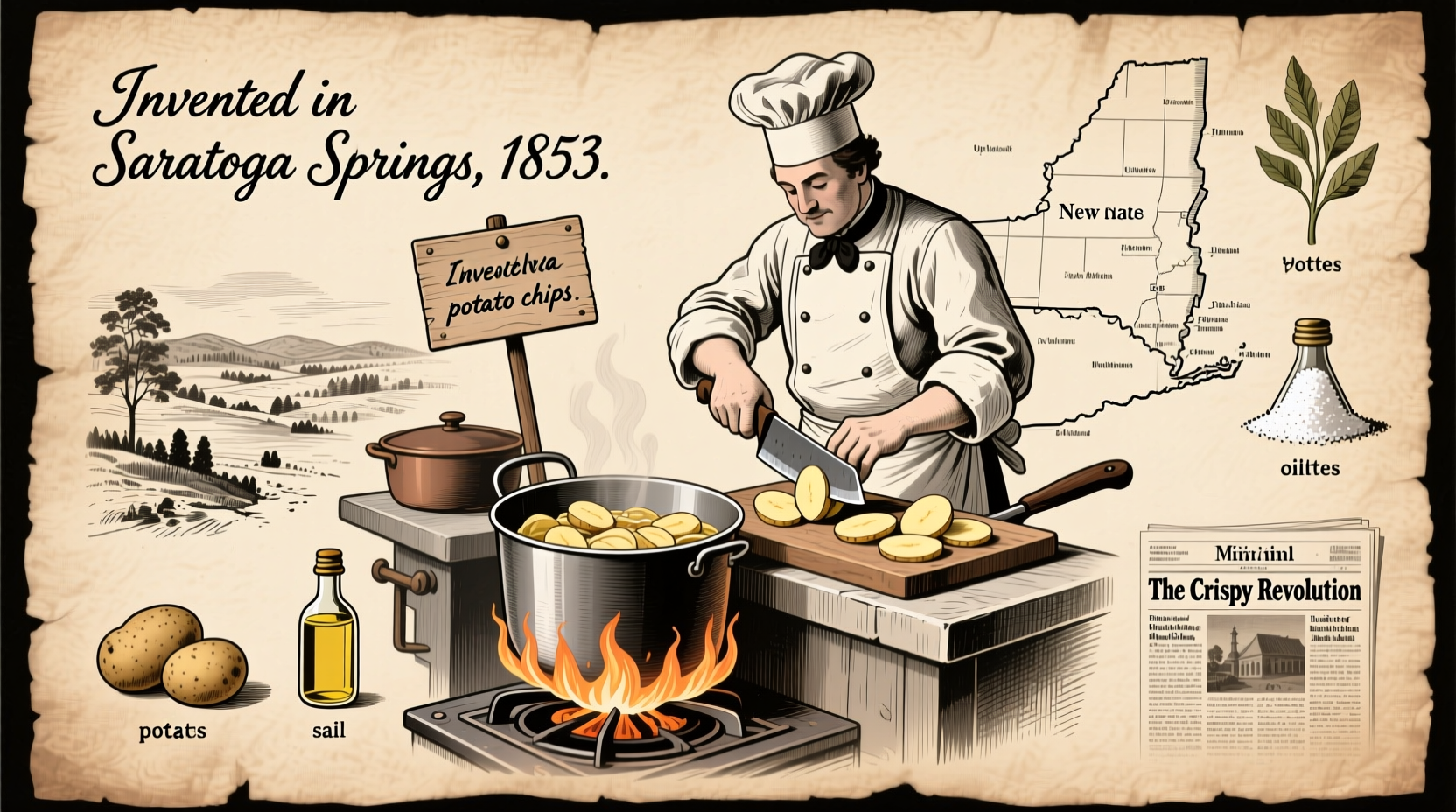Ever wonder how that irresistible crunch in your snack bag came to be? The story of potato chips begins not with corporate food labs, but with a frustrated chef and a picky customer in upstate New York. What started as kitchen revenge became a global phenomenon that generates billions in revenue annually.
The Saratoga Springs Origin Story
On a summer day in 1853, at Moon's Lake House in Saratoga Springs, New York, a customer repeatedly sent back his fried potatoes, complaining they were too thick and soggy. Chef George Crum, known for his temperamental nature, decided to teach the customer a lesson by slicing potatoes paper-thin, frying them until crisp, and loading them with salt.
To Crum's surprise, the customer loved them. Word spread quickly about these "Saratoga chips," and they became a signature dish at the restaurant. Within years, they appeared on menus throughout the region, establishing Saratoga Springs as the undisputed birthplace of the modern potato chip.
Historical Evidence Supporting Saratoga's Claim
While food origin stories often contain folklore, the Saratoga claim has substantial historical documentation:
| Historical Evidence | Source | Significance |
|---|---|---|
| 1880s newspaper references to "Saratoga chips" | Library of Congress Newspaper Archives | Multiple regional papers mention the snack by name before national commercialization |
| George Crum's 1892 obituary | Saratoga County Historical Society | Explicitly credits him with inventing "Saratoga chips" |
| 1895 cookbook reference | Buckeye Cookery (1895) | First published recipe for "Saratoga chips" |
Timeline of Potato Chip Evolution
The journey from restaurant specialty to global snack follows this clear progression:
- 1853: George Crum creates the first potato chips at Moon's Lake House
- 1880s: "Saratoga chips" become regional specialty throughout New York
- 1890s: First commercial production begins in small operations
- 1920s: Laura Scudder develops wax paper packaging, enabling mass distribution
- 1932: Herman Lay establishes first major potato chip company in the South
- 1950s: Introduction of flavored chips (BBQ, sour cream & onion)
- 1960s: Frito-Lay merger creates snack food giant
- Today: Global industry worth over $30 billion annually

Debunking Common Potato Chip Origin Myths
Several alternative origin stories have circulated, but historical evidence doesn't support them:
- The English Claim: Some suggest fried potatoes appeared earlier in England, but these were thicker "potato crisps" without the specific Saratoga preparation method
- The French Connection: While fried potatoes existed in France, the ultra-thin, crispy version that defines modern chips originated in New York
- The Accidental Oven Story: Tales of chips being invented when potatoes were left in an oven are folklore without historical documentation
The Saratoga Springs origin remains the only version supported by contemporary documentation, newspaper accounts, and culinary historians. The Smithsonian National Museum of American History recognizes this origin in their food history collections.
How Potato Chips Spread Across America
For decades, Saratoga chips remained a regional specialty. The transformation into a national snack required several key developments:
- Early vendors sold them in handmade paper bags on street corners
- Small family operations began packaging them for local markets
- The invention of mechanical slicers in the 1920s enabled consistent production
- Laura Scudder's wax paper packaging innovation (1920s) prevented staleness
- Herman Lay's door-to-door sales approach built the first national distribution network
By the 1950s, potato chips had become America's favorite snack food, with regional brands eventually consolidating into the major companies we know today.
Why This History Matters Today
Understanding the true origin of potato chips isn't just trivia—it reveals important patterns in food innovation:
- Many iconic foods emerged from culinary accidents rather than deliberate invention
- Regional specialties often require technological and packaging innovations to achieve national success
- Food history connects us to cultural moments and social contexts of different eras
- Knowing authentic origins helps preserve culinary heritage against commercial myth-making
Next time you open a bag of potato chips, remember that satisfying crunch represents a perfect storm of frustration, skill, and serendipity that began in a small New York restaurant kitchen over 170 years ago.
Frequently Asked Questions
Who exactly invented potato chips and where?
Potato chips were invented by George Crum, an African American and Native American chef, at Moon's Lake House restaurant in Saratoga Springs, New York in 1853. Historical records and contemporary newspaper accounts confirm this origin.
Was the invention of potato chips really an accident?
Yes, according to historical accounts, potato chips were created accidentally when chef George Crum deliberately made ultra-thin, crispy potatoes to frustrate a customer who kept sending back his fried potatoes. The customer unexpectedly loved the result, creating an instant sensation.
How did potato chips become popular nationwide?
Potato chips spread from a regional specialty to national popularity through several key developments: mechanical slicers enabled consistent production in the 1920s, Laura Scudder invented wax paper packaging to prevent staleness, and Herman Lay established the first national distribution network through door-to-door sales before the Frito-Lay merger created the modern snack industry.
Are there any historical documents proving the Saratoga Springs origin?
Yes, multiple historical documents support the Saratoga Springs origin, including George Crum's 1892 obituary that credits him with inventing "Saratoga chips," 1880s newspaper references to the snack, and the first published recipe in the 1895 cookbook Buckeye Cookery. The Saratoga County Historical Society maintains archives documenting this history.











 浙公网安备
33010002000092号
浙公网安备
33010002000092号 浙B2-20120091-4
浙B2-20120091-4